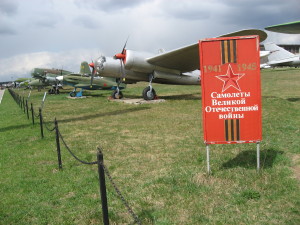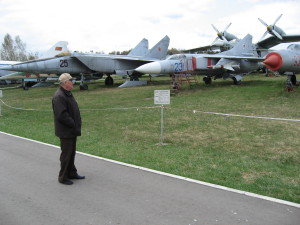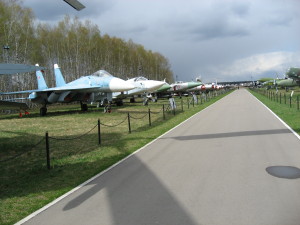
Central Air Force Museum: Monino
Arrangements to visit the Central Air Force Museum in Monino, about 40 kilometers as the crow lies from Moscow, must be made two weeks in advance. That's what the guidebook stated. Since it's a functioning Air Force garrison, visiting foreigners must fax their passport information and be accompanied by a Russian citizen. That's what the museum's website (Russian only) stated and the museum's receptionist reiterated over the phone. If not arriving by car, which would have to be registered, visitors had to take a taxi. Foreigners weren't supposed to take local busses or walk into the garrison.
As often happens in Russia, rules evaporate in practice. One never knows when they might be enforced, but rarely do Russians ever show concern about following rules to the letter. The taxi drivers at Monino seemed perplexed by the gaggle of foreigners bargaining for rides. Clearly they hadn't had much business ferrying foreigners to the museum. The ride cost 100 rubles or 4 US dollars.
No rules applied to getting back. Once we walked out of the museum, we were on our own. There's no taxi stand at the museum, so some of us flagged down local cars to get back to the train station. I made the 20-minute walk back with an Israeli tourist who latched on to our group while touring the exhibits. He visited without a Russian hostage, so that rule seems flexible in practice, too.
To get to Monino, we took the elektrichka, or suburban train, from the Yaroslavl train station in Moscow. The round trip ticket cost 125 rubles or 5 U.S. dollars, trains were frequent and the trip took about 90 minutes.
During the train ride, Russians walked the aisles selling items such as: document holders, magazines, blinking rubber balls, shower curtains, ironing board covers, art books, glasscutters, etc. Passengers seriously interested in the glasscutter could get an on-the-spot demonstration. Since the train schedule was set to change in a couple weeks, these entrepreneurs found a ready market for newly printed schedules.
Unlike last year on the elektrichka, no beer was sold. The loudspeakers blared why: "Smoking and the drinking of alcoholic beverages are strictly forbidden." During the announcement, the man behind me guzzled vodka and in front a teenager chugged beer. Nobody smoked.
We left the museum's small headquarters building and headed for a field. The building housed several interesting exhibits, such as one showing the successful performance of Soviet aircraft against the Americans during the Korean War. Unfortunately, a fire had required temporarily housing these exhibits in the administration building, and they weren't available for viewing.
It was early May, and a biting wind blew snow flurries into our faces. Our guide was Aleksey, a former test pilot who began flying in the early 1950s and had flown some of the almost 200 aircraft on display. A few of them were foreign, such as the American Lend-Lease planes from WWII, but most were Russian.

Guides aren't required, but you'd miss a lot without one. Aleksey's commentary was that of a professional. If he thought an aircraft was good, he said so and explained why. If it had major design failures, he explained them, too. Aleksey appeared to have an especially warm spot for the MiG-25 (Foxbat) and the Sukhoi-27 (Flanker). The major Soviet aviation design bureaus were represented: Tupolev, Mikoyan, Mil, Sukhoi, Yakovlev, Beriyev, Myassischev, Lyul'ka, Ilyushin, Antonov, Kanov.
Aleksey did delve into politics briefly when he mentioned disdainfully how Khrushchev had single-handedly set back Soviet military aviation by canceling the production of several promising new aircraft and by decreeing that in the future in the sky would belong to rockets.
Don't expect slick, Disney-like exhibits with lots of interactive features and fancy graphics. The museum is a huge outdoor parking lot with an adjacent building. Parked in rows are glistening metallic war horses: strategic bombers and missile carriers designed to carry nuclear weapons for killing hundreds of thousands of the enemy; attack aircraft to support advancing lines of ground units laying waste to enemy cities; and fighter interceptors, challenging attacking enemy aircraft. The adjacent building houses some quaint early 20th century aircraft, many of which were designed for military roles.

Thoughtful Americans or West Europeans should realize that this war machinery targeted them. These aircraft were designed to kill them and destroy their aircraft. Aleksey, a professional soldier, knew this instinctively, so he could easily talk about the good and bad of aircraft models much in the same way soldiers likely talked about horse breeds in the 19th century. He also spoke reverently about Soviet ace WWII pilots, such as Ivan N. Kozhedub (Russian only) who later commanded Soviet pilots against the Americans in Korea.
The museum is a work of love, not public relations. It presupposes some basic knowledge on the visitor's part and a passion for military aircraft. An independent English language website on the museum provides further information for aviation enthusiasts.
The museum also reflects the vast national resources that the Soviet Union devoted to building military aircraft. How to realistically restructure this complex, so as to maintain national defense, become competitive on foreign markets and keep tens of thousands of jobs, remains one of President Putin's major headaches. It will certainly be a headache for his successor, too.
6 May 2007
Home